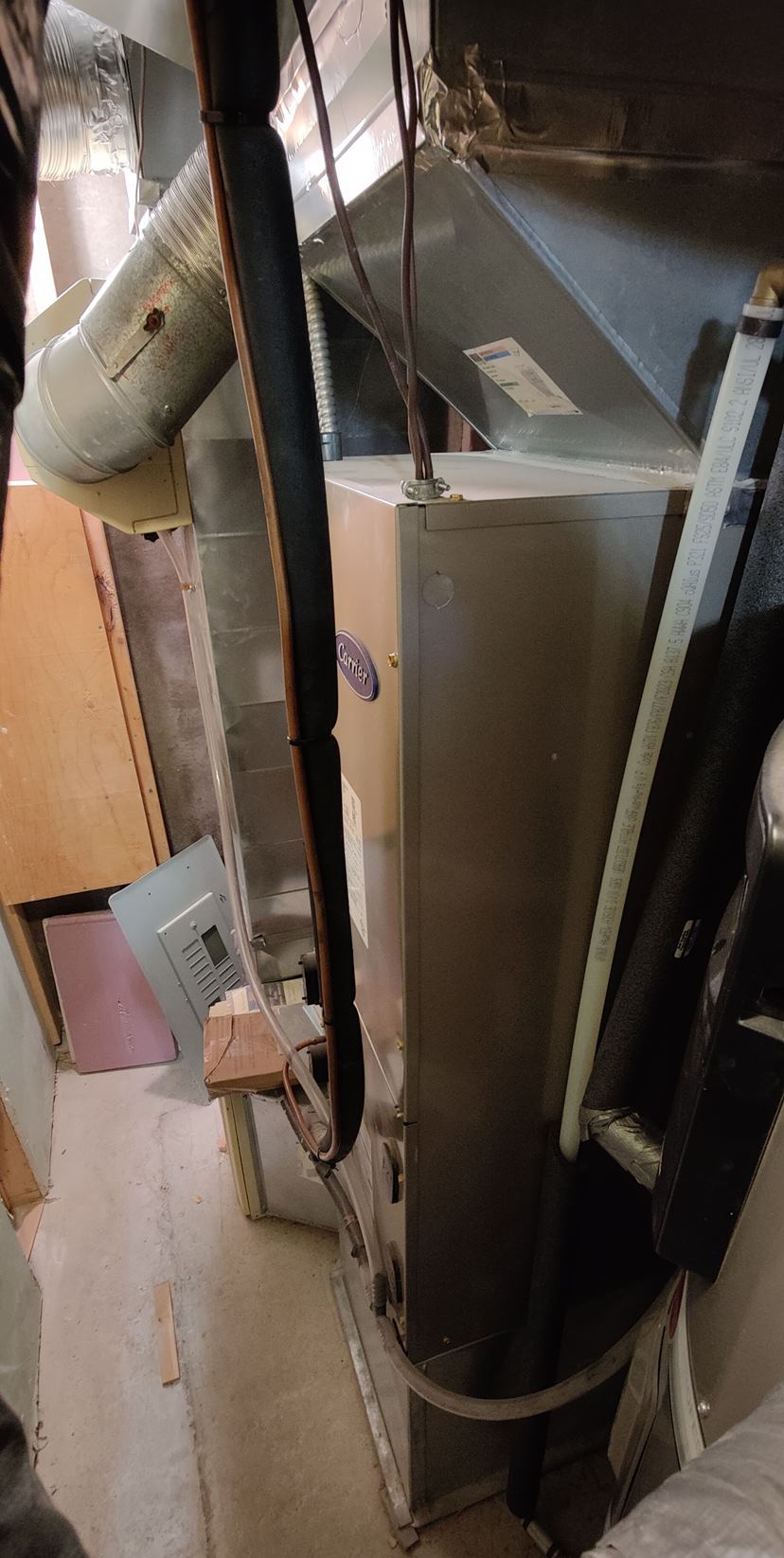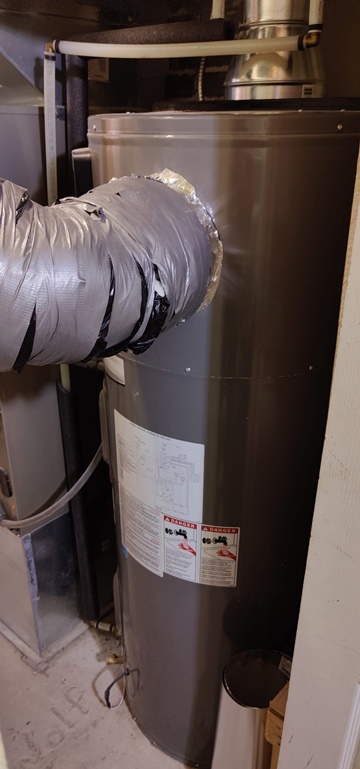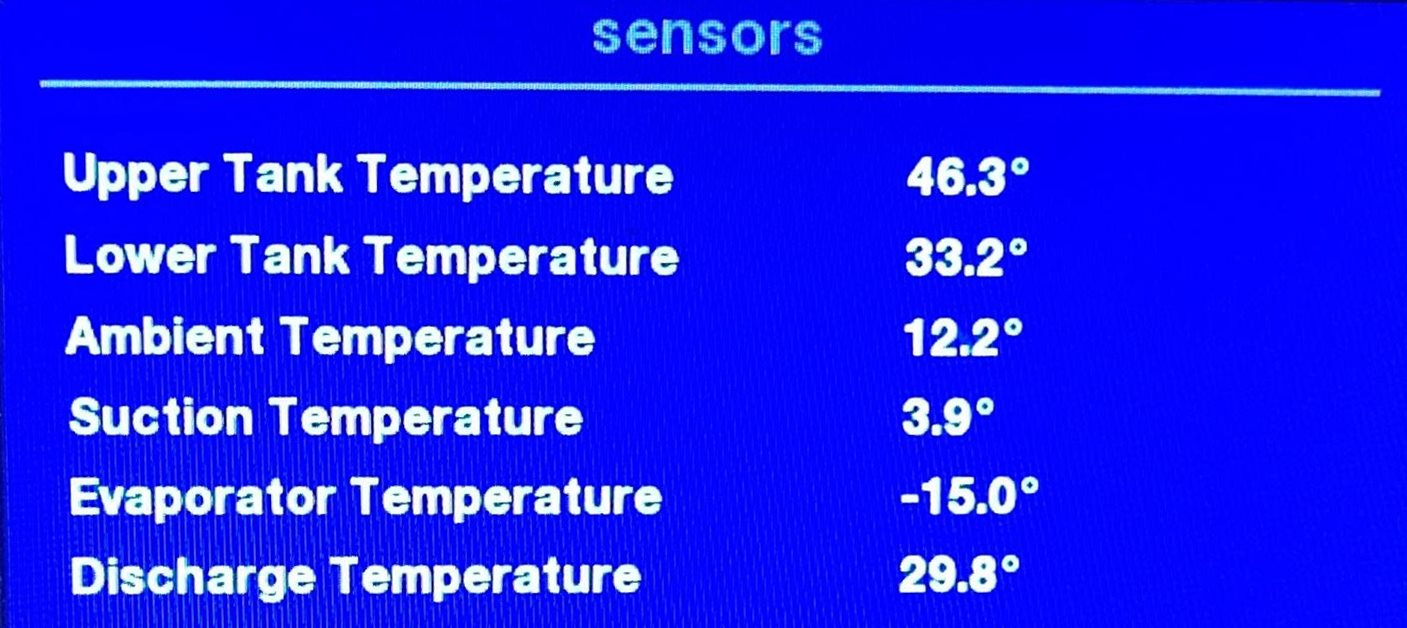
Indoor unit on my Carrier Heat Pump
Save on bills and save the planet
If you’re researching a high efficiency heat pump for the first time, you might be surprised to know that heat pumps are used by pretty much everyone, in one way or another, on a daily basis. Heat pumps are in most refrigerators and freezers, most air conditioners, most dehumidifiers, in some clothes dryers, and increasingly in home heating systems. And while they’ve been around in one form or another for over 160 years, heat pumps are a hot topic right now because they can play an important role in fighting climate change.
I myself am the proud owner of not one but SIX heat pumps:
- A refrigerator
- A chest freezer
- An ENERGY STAR dehumidifier
- A heat pump clothes dryer
- A hybrid high efficiency heat pump water heater
- A forced air high efficiency heat pump heating and cooling system
So I hope you’ll trust me when I say I know a little bit about how they work and what their advantages and disadvantages are.
In fact I think heat pumps are so important that I’m adding an entire new section to my site over the coming months (as of November 2021) to explain as much as I can about the different types, use cases, and benefits of high efficiency heat pumps.
In this section of my website I’ll go over the mechanics of heat pumps, and briefly describe the main new applications of heat pumps. If you want more in-depth information on a particular application of a heat pump, just follow the links above (where you see them — I am not done writing all these articles yet!). Beyond that I’ll briefly touch on:
- Heat pump mechanics
- Heat pump efficiency
- Heat pump operating costs
Mechanics and efficiency of a heat pump
A heat pump works by moving heat from one place to another. When your fridge compressor is running, ever notice the warm air blowing over the top of it or out the sides? That’s the fridge pumping heat from the inside of the fridge to the surrounding space of your home. When you run an air conditioner, of course you notice that cool air comes through the air ducts, but have you also noticed the air coming off the outdoor compressor? It’s generally hotter than the outdoor air.
It may seem counterintuitive that you can heat your home by pulling heat energy out of the cold outdoor air and pumping into your already warm indoor air. But again, that’s what your refrigerator has been doing all along – taking heat energy out of where you keep your milk and eggs (or oat milk and tofu) and pumping it into the already warm room.
I go into considerable detail on the mechanics and efficiency of heat pumps in my Heat pump efficiency article; check it out if you want a solid understanding of how heat pumps achieve their very high efficiency ratings. In brief we can say that a heat pump can deliver 2X or 3X or even as high as 4.7X as much heat energy to your home as the electrical energy it takes to operate it, because it isn’t converting the electrical energy to heat energy; instead, it is converting electrical energy into mechanical energy to operate the compression / evaporation cycle, which in turn is extracting heat from one area and radiating that heat into a different area.
When we say a heat pump is 300% or 400% efficient that’s not quite correct. It’s more correct to say that the heat pump can extract 3 or 4 times as many units of heat energy, from the outside air, as it consumes in the form of electricity. This 3 or 4x factor is called the coefficient of performance.
For home heating applications, the co-efficient of performance is an important metric to consider when looking at different options, but it is also very dependent on weather. Each heat pump has a CoP curve that defines how many units of output heat energy are produced per unit of input energy at different temperature differentials. The bigger the gap between indoor and outdoor temperatures, the lower the CoP for any heat pump. In extremely cold weather the CoP may drop below 1.0, which means the heat pump becomes less efficient than regular electric heating. In spring or fall weather when the outdoor temperature is close to indoor temperatures, the CoP can approach 5.0.
Heat pump operating costs
In a moderately cold climate like my home town of Toronto, heat pump operating costs are likely to be lower than those of a high efficiency natural gas furnace. There are a number of reasons for this:
- Relatively mild winters mean you can take advantage of high CoP for most of the heat pump’s operating season
- If you’re in a jurisdiction that puts a price on carbon, that adds to the cost of the natural gas. It may also add to the cost of your electricity, but likely to a lesser extent, as very few markets derive 100% of their electricity from fossil fuel sources.
In my case, I’m actually saving money with my heat pump, as of 2021, compared to what I used to spend running my 95% efficient natural gas furnace. By 2030, I estimate I’ll be saving several hundred dollars a year because of the Federal Carbon Tax that is in effect in Ontario (in case you’re wondering, I’m 100% in favor of the carbon tax!). Read my Heat pump operating costs article for more details on my experience switching from natural gas to heat pump forced air.
Common heat pump applications
I do plan to flush out detailed articles on the common uses of heat pumps in residential settings, but until then, the following brief overview will have to do. Come back here every so often and look for updates!
Heat pump clothes dryers

Whirlpool Heat Pump Dryer
Heat pump clothes dryers (also called ventless clothes dryers, although not all ventless clothes dryers are heat pump dryers) are a relatively new phenomenon in North America but already very well established in Europe and parts of Asia. I installed one a few months back to replace my natural gas dryer. A heat pump clothes dryer runs a closed air cycle where moist air from the dryer tumbler passes over the condenser coils of the heat pump, which causes the moisture to condense out of the air, from where it drains into the same pipe your clothes washer drains into (or drains into a tank you have to empty every so often). The air then passes to the evaporator part of the heat pump cycle, where heat extracted at the condensor stage is pumped back into the air. Two great things about heat pump dryers from an energy efficiency perspective:
Rated efficiency: They’re at the top of the efficiency curve compared to gas and electric dryers. ENERGY STAR dryer efficiency ratings are expressed as Combined Energy Factor or CEF ratings, the higher the better. All of the most efficient electric clothes dryers on the ENERGY STAR website are heat pump dryers, with CEPs as high as 10.14, while the most efficient non-heat-pump dryer has a modest CEP of 3.94 (this means a heat pump dryer can be up to 2.5 times as efficient as a regular dryer.
Added savings from not venting: Heat pump dryers don’t vent air outside. This means in summer, you’re not drying cool, dehumidified air from indoors and dumping it outside, thus adding cooling load to your air conditioner (or just making your hose warmer by pulling in warm air, if you’re relying on passive cooling). And in winter, you’re not pumping heated air outside.
Heat pump water heaters

My heat pump water heater
Heat pump or hybrid water heaters are another relatively new phenomenon in North America. A hybrid water heater has both an electric heating element, similar to a standard electric hot water heater, as well as a heat pump. A heat pump water heater can either draw warm air from and dump cooled air back into the space it’s installed in, or it can be vented to the out of doors. I bought a heat pump water heater in August 2020; in warm weather, I let it draw air from the basement, which both cools and dehumidifies the basement; in cooler weather, I connect ducts to it so it draws cool air from the outside, and pumps much colder air back outside. It has a display for setting temperature and heating mode and viewing status; it’s quite amazing to watch the temperature sensors. For example, today as it started up heating, it was drawing in 4C air, discharging hot water at 30C (working its way up to 46C which is the peak temperature setting) and dumping cold air back out from the evaporator at -15C! I’ve measured the air coming out of the cold air vent, and in cold weather it can drop as low as -6C. A couple of benefits of these heaters:

Temperature differentials while heating water
Rated efficiency: Water heater efficiency is measured in Uniform Efficiency Factor or UEF; it’s a formula that smooths out the performance / tank capacity differences of different types of water heaters so you get an apples to apples comparison of energy efficiency. A traditional electric water heater has a UEF of around 0.93 to 0.95. A hybrid electric water heater or heat pump water heater has a UEF of 2.3 to 4.0. (In fact in the list of ENERGY STAR electric water heaters, this gap from 0.97 to 2.3 is precisely the point at which the list switches from electric resistance tanks to heat pump tanks.)
Works in any weather: If the temperature of the air source drops enough that it becomes less efficient to operate the heat pump than to operate the electric resistance heater, the heat pump automatically switches to electric mode. The heater can also combine the heat pump and electric resistance heater modes at times of high demand to ensure a steady supply of hot water. This means you can connect the air intake and exhaust to the outdoors year-round; when it’s too cold for the heat pump to extract heat from really cold outdoor air, it just uses the resistance heater. It has an “Eco Mode” setting that determines which heating source to use in order to maximize efficiency.
Provides air conditioning in hot weather: My basement actually got so cold this summer from my operating my hybrid heat pump water heater, that I temporarily reconnected the ductwork just so it wouldn’t keep making the basement so cold.
If you have a large unfinished basement that you don’t spend much time in, it may be fine to install a heat pump water heater without any outdoor venting. Bear in mind that this will be less efficient than a vented one at least when you’re heating the house: the heat has to come from somewhere, and if you’re drawing warmth from the indoor air, your furnace or boiler or home heat pump has to produce that heat!
Note that if you heat with radiators, another option is to use a heat pump hydronic system that provides hot water both to your radiators and to your hot water tank.
Heat pump forced air central heating/cooling
This is a heat pump system configured similar to a forced-air air-conditioning system with an outdoor unit (the “compressor” section of the air conditioner) and an enclosed indoor unit that includes heat exchanger coils and a fan. If you already have a forced air heating/cooling system this is the ideal replacement for both your furnace and central air conditioner. I purchased a Carrier Infinity GreenSpeed heat pump in mid 2020; it’s one of the most efficient on the market. Included in the installation was a 20,000 watt electric resistance heater so that on really cold days when the heat pump is inefficient, the heating can keep up.
Heat pump hydronic central heating/cooling
Hydronic systems are a little trickier when it comes to heat pumps. Most heat pump hydronic systems can only heat water to about 45C, which works for homes with an extensive array of radiators, or with under-floor hydronic heating. But for older homes with cast iron radiators, this heat may not be sufficient. A typical older North American home with a natural gas boiler and old cast iron rads was designed for boiler temperatures of 70C or thereabouts: the high temperatures were needed to allow the water to circulate naturally, without a pump, using convection. More modern hydronic heating systems also used high temperatures, but in this case the high temperature was partly to improve energy efficiency of the carbon-based fuel source.
Switching to a heat pump system with a 45C maximum hot water temperature will provide some heat, but probably will not heat your home quickly when the temperature suddenly drops, or when you turn up the thermostat; the system will be running more often; and the house may struggle to maintain comfort temperature on the coldest days. A switch like this might work for Toronto, where it’s rarely below -15C for more than a few hours at a time. But it’s certainly not good enough for Winnipeg!
Some good news on this front though:
- New hydronic heat pump systems are expected on the market shortly, some of which should address the 45C temperature limit
- Some hydronic heat pump systems can partially heat the water, and on the coldest days an electric resistance heater can supplement that heat
- You can add additional more modern rads to your setup if you convert to a low temperature heat pump system
- You can ad an alternate source such as a ductless minisplit heat pump, so that a portion of your heat is supplied by that.

Leave a Reply
Want to join the discussion?Feel free to contribute!